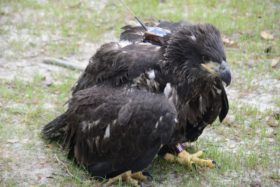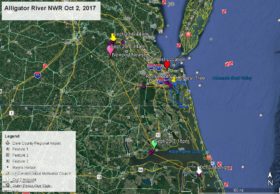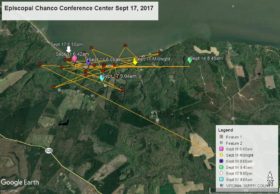Eagle Hearing/Ears
Azalea Still Close By March 3
March 3, 2010Azalea Returns to Norfolk Botanical Garden
March 3, 2010

A frequent question on the WVEC web cam chat is do eagles have good hearing and where are their ears? Unlike humans and many other animals that have visible ears, birds ears are hidden behind feathers on the side of their head. On bald eagles the ears are located behind and slightly below the eyes. Many studies have been conducted to determine just how well birds can hear. To keep it simple, diurnal birds (those active mainly during daylight hours like bald eagles) have hearing about equal to that of humans, while nocturnal birds (those active mainly at night) have much more sensitive hearing. That is especially true of Barn Owls and Great Horned Owls.
It is very obvious that these eagles at Norfolk Botanical Garden use their hearing to call back and forth to each other. We have seen this during mating and when one is ready to be relieved of egg incubating duty. Also, when they feel threatened by another eagle entering their “territority”.




2 Comments
Mr. Lukei – Thanks for sharing your knowledge and keeping us educated about these amazing birds. It’s amazing watching their almost human interactions.
thank you for this informative article !the eagle cam is so interesting . my entire family has enjoyed and learned much from your staff and by watching the eagles. We live near by the Mississippi river and can now appreciate our own eagles with new knowledge and interest…thanks! cindy